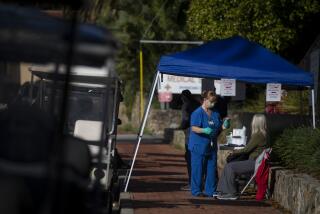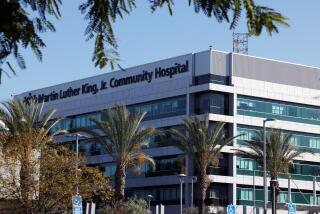Hospitals in L.A. County could absorb some patients if King-Harbor closes
- Share via
Hospitals in Los Angeles County could absorb patients from Martin Luther King Jr.-Harbor Hospital if the facility closed, but only if more emergency room and critical care beds were added nearby, according to a report released Monday.
The Hospital Assn. of Southern California measured the emergency capacity near King-Harbor and determined that an additional 20 emergency room beds and four critical care beds were needed at hospitals within a 3-mile radius of the facility in Willowbrook, south of Watts. The association issued its report after last week’s release of the county’s contingency plans in case the public hospital is closed.
“We can make the county’s plan work if everyone acknowledges that the capacity needs to increase,” said Jim Lott, the association’s executive vice president.
Dr. Bruce Chernof, county director of health services, said in the contingency plan that closing King-Harbor would have “an adverse impact on the [emergency care] system and on this medically underserved community.”
Lott agreed. He said that even with the extra beds, patients could face delays in getting to hospitals. He noted that if King-Harbor were shut immediately, the county plans to send ambulances to different hospitals on a rotating basis.
“That means that an ambulance will bypass a hospital that is open only because it took the last patient,” Lott said. “It will increase waiting times and treatment times.”
The number of emergency room visits to be absorbed is less than first thought, Lott said. The report found that since the downsizing of King-Harbor last year, the number of emergency room visits to the facility is expected to fall from 47,000 in 2006 to 25,000 this year.
But Lott cautioned that the county cannot plan for whether walk-in emergency patients near King-Harbor would travel on their own to other hospitals or whether specialized emergency physicians at those hospitals would be willing to treat an influx of indigent patients.
If not, local hospitals could find it difficult to give the type of care that emergency rooms must provide, he said.
More to Read
Sign up for Essential California
The most important California stories and recommendations in your inbox every morning.
You may occasionally receive promotional content from the Los Angeles Times.














